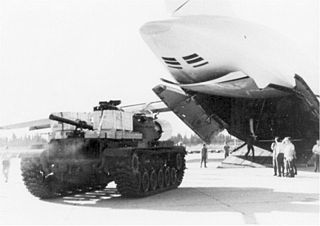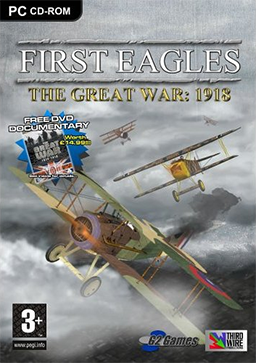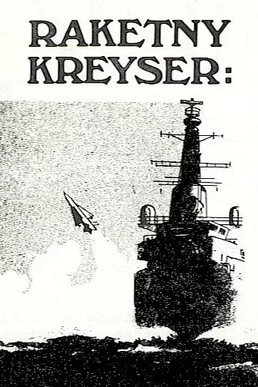
World War III, World War 3, WWIII, WW3, or the Third World War are the names given to a hypothetical global conflict subsequent to World War I and World War II. The term has been in use since as early as 1941. Some apply it loosely to limited or more minor conflicts such as the Cold War or the war on terror. In contrast, others assume that such a conflict would surpass prior world wars in both scope and destructive impact.

The War of Attrition involved fighting between Israel and Egypt, Jordan, the Palestine Liberation Organisation (PLO) and their allies from 1967 to 1970.

An airstrike, air strike, or air raid is an offensive operation carried out by aircraft. Air strikes are delivered from aircraft such as blimps, balloons, fighter aircraft, attack aircraft, bombers, attack helicopters, and drones. The official definition includes all sorts of targets, including enemy air targets, but in popular usage the term is usually narrowed to a tactical (small-scale) attack on a ground or naval objective as opposed to a larger, more general attack such as carpet bombing. Weapons used in an airstrike can range from direct-fire aircraft-mounted cannons and machine guns, rockets and air-to-surface missiles, to various types of aerial bombs, glide bombs, cruise missiles, ballistic missiles, and even directed-energy weapons such as laser weapons.

Aerial supremacy is the degree to which a side in a conflict holds control of air power over opposing forces. There are levels of control of the air in aerial warfare. Control of the air is the aerial equivalent of command of the sea.

Conflict: Middle East Political Simulator, often known as ConfMEPS or simply Conflict, is a turn-based government simulation game designed by David J. Eastman and published by Virgin Mastertronic in 1990 for DOS, Atari ST and Amiga. Although the game is no longer commercially available, original designer David J. Eastman has encouraged players to download the PC version from "abandonware" sites.

Operation Nickel Grass was the codename for a strategic airlift conducted by the United States to deliver weapons and supplies to Israel during the 1973 Arab–Israeli War. Between 14 October and 14 November of that year, the Military Airlift Command of the United States Air Force shipped approximately 22,325 tons of supplies, including tanks, artillery, and ammunition, in multiple flights of C-141 Starlifters and C-5 Galaxys. This initiative was undertaken to help improve the position of the Israeli military in the face of a large-scale joint offensive by Egypt and Syria, both of which had been receiving extensive support from the Soviet Union.

The history of the Iranian Air Force, currently known as the Islamic Republic of Iran Air Force, can be divided into two phases—before the Islamic Revolution, and after it.

Naval tactics and doctrine is the collective name for methods of engaging and defeating an enemy ship or fleet in battle at sea during naval warfare, the naval equivalent of military tactics on land.

Wings Over Vietnam is a PC combat flight simulation game set during the Vietnam War over South East Asia and covers the time period between 1964 and 1973.

Strike Fighters: Project 1 is a 2002 combat flight simulation video game that primarily centers on a fictitious conflict in the Middle East between the Kingdom of Dhimar and the Empire of Paran, two sides of a proxy war between the United States and the Soviet Union, between the late 1950s and the early 1970s. Although the countries and conflict may not be real the aircraft and weapons used are completely accurate.

Military simulations, also known informally as war games, are simulations in which theories of warfare can be tested and refined without the need for actual hostilities. Military simulations are seen as a useful way to develop tactical, strategical and doctrinal solutions, but critics argue that the conclusions drawn from such models are inherently flawed, due to the approximate nature of the models used. Many professional analysts object to the term wargames as this is generally taken to be referring to the civilian hobby, thus the preference for the term simulation.

Third Wire Productions Inc. is a C corporation based in Austin, Texas, United States; it is an independent software development company founded in 1999 to create multimedia entertainment, such as amateur flight simulators and strategy video games.

First Eagles: The Great War 1918 is a PC combat / flight simulator game that focuses on World War I between 1917 and 1918.

The General Dynamics X-62 VISTA is an experimental aircraft, derived from the F-16D Fighting Falcon, which was modified as a joint venture between General Dynamics and Calspan for use by the United States Air Force (USAF). Originally designated NF-16D, the aircraft was redesignated X-62A in June 2021 as part of an upgrade to a Skyborg, with System for Autonomous Control of Simulation (SACS).

Strategic Command 2: Blitzkrieg is a grand strategy computer game developed by Canadian studio Fury Software, and published by Battlefront.com in 2006. The second game in the Strategic Command series, Blitzkrieg is a turn-based strategy set in World War II, focusing on the European Theater. The player controls all of either Axis or Allied states.

Down in Flames is a computer video game for Microsoft Windows, developed by American studio Dan Verssen Games and published by Battlefront.com in 2005. Closely based on a card-driven tabletop game of the same name, Down in Flames is a turn-based simulation of dogfights between World War II fighter planes. Some parts of the game also involve escorting and intercepting bombers.

The Anglo-Soviet invasion of Iran or Anglo-Soviet invasion of Persia was the joint invasion of the neutral Imperial State of Iran by the United Kingdom and the Soviet Union in August 1941. The two powers announced that they would stay until six months after the end of the war with their enemy Nazi Germany, which turned out to be 2 March 1946. On that date the British began to withdraw, but the Soviet Union delayed until May, citing "threats to Soviet security".

A nuclear close call is an incident that might have led to at least one unintended nuclear detonation or explosion, but did not. These incidents typically involve a perceived imminent threat to a nuclear-armed country which could lead to retaliatory strikes against the perceived aggressor. The damage caused by international nuclear exchange is not necessarily limited to the participating countries, as the hypothesized rapid climate change associated with even small-scale regional nuclear war could threaten food production worldwide—a scenario known as nuclear famine. There have also been a number of accidents involving nuclear weapons, such as crashes of nuclear armed aircraft.

Raketny Kreyser, subtitled "Tactical Naval Combat, 1975-1999", is a naval board wargame published in 1977 by Simulations Canada (SimCan) that simulates hypothetical naval battles in the latter part of the twentieth century.


















